| << UbuWeb |
| Aspen no. 3, item 7 |
|
|
| Homeward Bound: The Rand House |
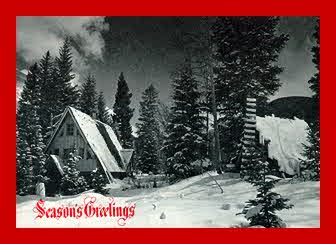
|
|
""HOMEward Bound, I wish I was... HOMEward Bound, HOME... where my thought's escapin' HOME... where my music's playin' HOME... where my love life's waitin' Silently for me..."* For two young wanderers — Chuck Rand, 32, and his 26-year-old Parisienne wife, Lydia — HOME is the place where you end one trip and start planning the next. HOME is the place you build yourself, using strictly local materials, but furnishing it with artifacts you gather from all over the world. HOME is an acre of wilderness at the end of the road, at the junction of Conundrum and Castle Creeks, outside Aspen, where the nearest neighbor is nowhere. * © 1966. Words and music by Paul Simon of Simon & Garfunkle. Eclectic Music Co., publisher. Used with permission. |
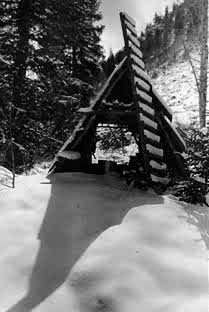
""This is where we lived while building
|
|
Photos and interview with Chuck and Lydia Rand by Bob Chamberlain Musical background: Simon & Garfunkle's "Homeward Bound" ""...I'm sittin in the railway station..." (Bob) When did your last trip start? (Lydia) Where did it start? (Chuck) Well, we bought a Volkswagen bus in Germany, ah... ""...got a ticket..." we got it from the factory in Hanover, right? And then we spent about six months messing around in Europe seeing Lydia's parents and everything, and then we went to, ah... ah... ""...for my destination..." ...ah...Switzerland. We got our visas in Switzerland, and... drove to Yugoslavia. From Yugoslavia, we drove into Rumania and then went down through Bulgaria, and to Greece and down into the Middle East to Lebanon and then across... ""...on a tour of one-night stands..." ah... oh Christ, to Iran, Afghanistan, and Pakistan, and India, finally ended up selling the car in Nepal, and then went back to India and, ah... ""my suitcase and guitar in hand..." made it to Bangkok and Hong Kong and Japan and then around this way. The whole thing took about a year and a half... ""...Homeward Bound..." but the only part we actually drove was from Europe to Nepal... and that was almost as much of a scene as the house was! ""...I wish I was Homeward Bound..." 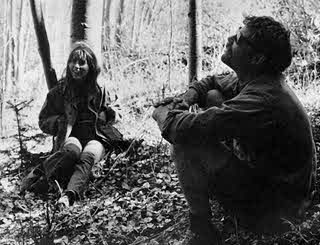
• How did you get started on the idea of building your own house anyway? I mean, did you... • Well, I've always wanted to build a house that was, you know, just stone and wood — forget all that plaster and stuff. Really, besides the sink and the oven top and the toilet and the sink, everything's either glass or wood. There's no plywood, there's no plaster, there's no paint anywhere — no paint at all. • But how did you get hooked in Aspen to do it? • Well, I had met a couple guys — Walter Schull and Bob Tattenham — in Europe, so I came through here to see them and I really liked it — it was the off-season. Walter said he would be interested in building something like this with me, so we sort of looked around, and found this piece out here. Started making something, you know, that we — oh, I don't know — something both of us wanted to do. I guess the over-all idea was to live in something we'd actually built ourselves. Then we tried to use only materials from around here. All the beams are lodge pole pine that Pete Luhn cut for us up on Dry Woody. All the stones are from rock slides up behind the house. Everything is from here — except for the roof and the shingles, of course, although I read a cabin book that says you should make your own shingles, too. (Laughter) Neither of us, as a matter of fact, had ever built a house before. We didn't know the first thing about it, so we did a lot of things, you know, just the logical way it seemed to do them, that nobody else does, like making the whole bathroom out of redwood. Nobody ever builds that way. I even used redwood for the shower, and you never see a shower out of wood — you know, it's always some funny tile or metal. But the redwood can take it. • Everything worked out all right, didn't it? |
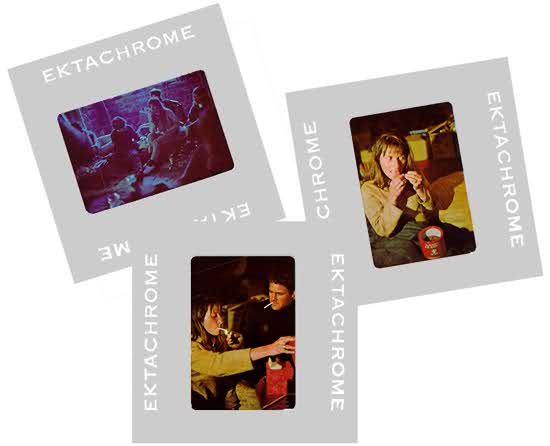
|
""We tried to use only materials from around here — all the stone
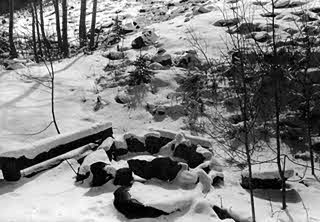
• Yes, almost everything worked out all right. They're very few really serious screw-ups in the house, that we haven't gotten rid of, you know, any bugs that were unworkable. The main thing is, of course, the structure, and we figured all that out, about the stresses on the wood and stuff like that. • Oh, you did? • Yes... Walter's engineering... he was really slide-ruling it, seeing that it would take the pressure and all that stuff, and then we built our footings about twice as big as we needed to, just to make sure it wouldn't settle. When you don't know, you sort of have to go — you have to overdo it, make it stronger... • Had you had any experience as carpenters or anything? • No. • Just kind of started in? • Yes — and then we just sort of did things as they came up. For instance, while we were digging the footings, we hit our well. • You didn't know about the well when you started? • No. We had planned to pump water from the creek, but we were digging the footings and we pulled out a great big rock — oh, about 3 feet in diameter — and we pulled it out, and the hole kept filling up with water. (Laughter) So, we just cased it and left it there, and that was our water system. We built the house right over it. You know, the hillside used to come right to the level of the kitchen, and then sloped to about here. We dug this all up. Silly, because we never brought in a digger; we just dug it by hand. There was a great big spruce tree right where the fireplace is. • (Lydia) We should have left it. |
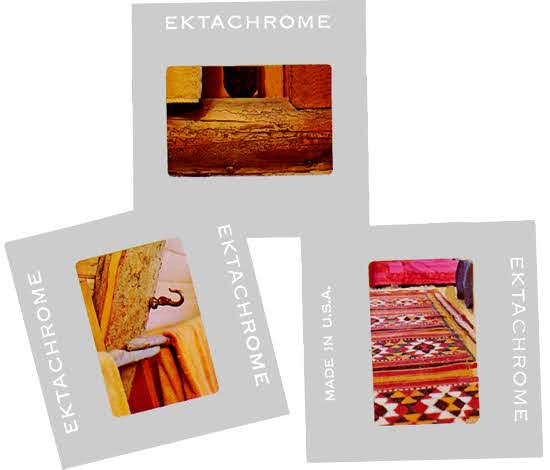
|
• Well, we were thinking about it. We spent one whole summer building the foundation and the stone walls — they're over 7 feet tall, you know. The next summer, we got the roof on and got it closed in... • (Lydia) Then we thought it was finished! (Laughter) •... but it still wasn't livable. What is so hard, you know, is using logs and mine timbers that are all uneven. For instance, these beams that go around on the sill, they're not all the same width — they're not all the same height! So when you try to use finished lumber for the floor and the roof and stuff, you run into a problem trying to fit the two together. So it doesn't leak — very much! (Laughter) • I didn't think it leaked at all. • Oh no, as far as water it doesn't. But some cold air comes in. • (Lydia) Oh some cold air comes in! (Laughter) • I got the idea to do the sun porch, because all along the dormer, where it breaks from being an A-frame, there was a leak all the way along when it rained and snowed. So I went up there and put flashing in, and then tar, and then covered it all over with a porch which we hadn't planned at all. • What was probably the hardest thing — the single, hardest job you had in building the house? Stonework? • The stonework. And then raising the A's. First we built these 7-1/2 - foothigh stone walls — sort of a stone box for each room — and then we put the A's together on top of them and then hauled them up one by one. • How tall are the A's? • Well, they're 20 feet on each leg of the triangle; they're all equidistant. We laid them on top of these stone boxes, and then to raise them we had a pulley up there. It was quite a thing! We didn't realize how big the house was going to be until we set up the first A. You know, the stone boxes we were working on kept looking smaller and smaller and smaller for a house. And then when we set these A's up, they towered over us like the Empire State Building. Then we realized there was going to be a lot of room. There's as much room in the guest room as there is in the living room area. You just lose sight of it when there is nothing but the stone. |
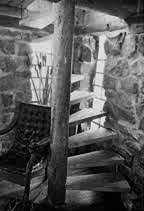
|
• What was the easiest part? • To a degree, plumbing and electricity were the easiest. They're really not very difficult, once you get an idea of what the theory is — how they're supposed to work. But doing it — putting the pipe together and stuff like that — wasn't very hard. The house changes all the time. For instance, this thing, this little A that comes out over the front entrance. We didn't plan it, you know, it just snowed too much. This winter, when I came back from India, we came out here and the snow was, you know, right up to about 6 feet, and it was hard to get in. So this A protects that. • What other things didn't you start out to do? • Well like I told you, this big sunporch up on top, and that little A, and — what else? Well, here's another major thing that wasn't planned, this wood floor here in the living room. That was all stone, at first, and it was too damn cold, so I laid a whole oak floor over it and made the stone hearth. That was Lydia's idea. • And this stairway, you just finished that a couple of days ago. • The circular stairway. Yeah, I really didn't have enough room to put a circular stairway there, but I figured it would make such a nice stair that it didn't matter if you had to duck your head a little bit, but, you see, you have to kind of contort to get up there. • And the glass brick, there, behind the stairs, weren't you originally planning something with stained glass? • Yes, and eventually I will. What I may do is move the glass brick in back for insulation and then put a whole frame of stained glass in front of it, you see, just so I get the light coming from in back of it. But that's a couple of years from now! 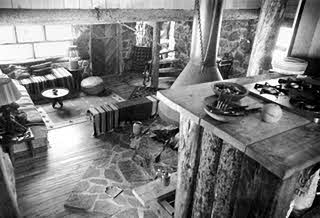
• What's this sort of triangular thing on the wall in the bedroom? • That's a Rajastan wood. It's from Rajastan in northwest India and from Pakistan — Lydia and I really went wild in India and Nepal buying stuff for the house. The Mask of Kali is from Nepal — she's the Goddess of Destruction — and the Goddess of something else. What is she the Goddess of? • (Lydia) Depends on which part of the country. • Anyway, she has a twofold thing, but the only one I remember is Destruction. • And then how about the stones? • This is a Shiva and Parvati, and — what are these other two, Lydia? I forget. • Vishnu. • Where did you get those? • The one of Shiva and Parvati we got in a crazy little place in Calcutta. The guy, he runs a very small shop, used to be curator of one of the museums there. He really has some of the best things in Calcutta. The only thing he hasn't got is an export permit. I took it out in a trunk — Burma Airways (laughter). The Vishnu we got in Kashmir. • What's this funny-looking lamp here? • Oh, that's Nepalese. It's one of the pieces that holds up the roof on the pagodas; houses, too. • And how about these stone ash trays? • Oh, they came from right off the coast at La Jolla, California. You go out after a storm and dive for them; they're in about 20 feet of water. They figure they're from an Indian civilization that's about 5,000 years old. They didn't make much except these things; they went ape on ash trays. (Laughter) The World's Great Ash Tray Civilization. They didn't have to work, you know, they had all those crazy seafoods and fish and mussels, all that stuff, so they just made a few things. • What's this brass tray you use for a coffee table? • Oh, that, my father got from Morocco... when he used to be in the diplomatic service. And we got about three rugs in Afghanistan, the orange and purple one in the guest room, and the one up in our room — the red and mustard-yellow job. And these things in the stairwell are Hopi Indian baskets that my father and mother got in Taos back in the thirties, and I got hold of them. Oh yes, the rosewood tables in the guest room are from Hong Kong. We weren't sure they were going to fit up there but it's nice; almost everything fits in and it doesn't seem to matter, you know. Like up in the guest room — after we bought those tables, we started thinking well, they're super, you know, classical Chinese, and will they go up there; but they look fine. And the same with the Indian statuary. • What's the trunk in your bedroom? • That's also from Hong Kong. We got it with the tables. • Well, ah, what have you left to do on the house? • Oh, God! (Laughter) The kitchen has to be completely done. It's the room that's completely unfinished. It's going to be quite a bit different — you know, there will be some cabinets. There will be some open shelves but not all of it, and then there will be an oven underneath the stove top. You can see the paneling is not even finished in there. |
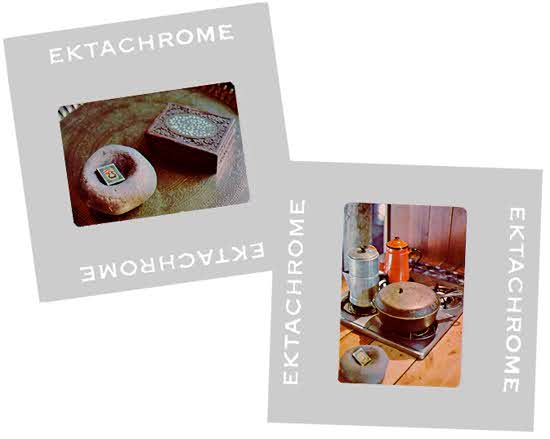
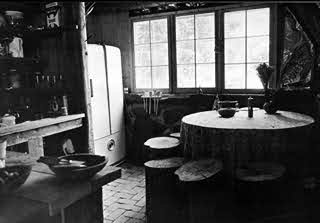
• You don't have an oven yet? • No, and I really wish we did, in order to make bread, anyway. And another thing that has to be done is I ought to put in a new oil tank. I learned something, this winter living out here in the cold, and I mean, a 1,000-gallon oil drum. I have a 500-gallon drum outside, but it sprung a leak as it was being filled so we hauled in 16 gallons of oil every three days all through the winter on the sled, because we were walking in — you know, the roads are not plowable up here, so we walked in... • You hauled all that stuff in by sled? All the way! • (Lydia) Our Husky, Bodi, helped us! • I got him to pull about 40 pounds, but he'll do better next winter! He's only a puppy! (Laughter) We thought we weren't going to like the walk very much at first, that it was going to be a drag walking in, you know, half a mile or so every day, but every time we came out here and walked in, it was always great. • Well, now tell me, don't I remember your saying something about never doing this ever again? • (Lydia) Every week! (Laughter) • Well, I'm sure I probably will, but the thing is, I won't try to do it all by myself next time, you know. it's really too much. • You mean, you'll hire more of the work out? • Yes, sure; it's ridiculous spending a whole summer doing nothing but stone work. Then all these windows were done by hand. We didn't have any super power tools, most of them were done with a hammer and chisel, all these cuts... • Are you seriously thinking that you'll end up building another one somewhere else? • Well, only if I move from Aspen. Actually, if I build another house around here, I'd like to build up on a mining claim somewhere and have no running water, no electricity, and no... • (Lydia) No problems! (Laughter) • No problems, exactly! • Yes, but the trouble is, like with this house, didn't it start out to be that kind of thing? • Well, not really. It's pretty big to be that kind of thing in the first place. If you want a house that you can heat with a wood stove or something like that, it has to be a very small house, and this is too big, so already you're in trouble. You have to have either an oil system, or a natural gas or bottle gas system or something like that, because it's just too big — you can't cut that much wood. |
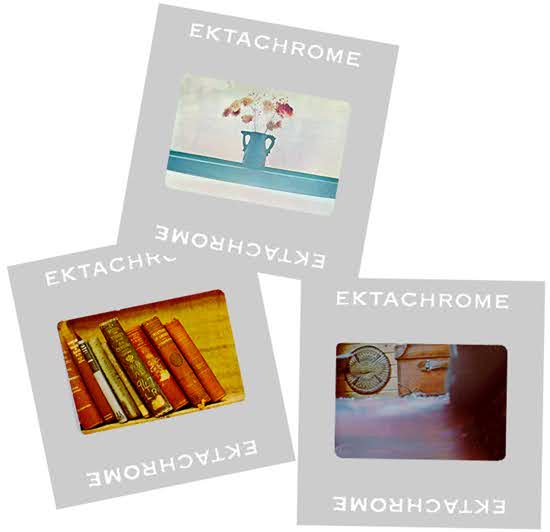
• But if you just build a very small place, and have it near enough to water — you see, this is near enough to the creek so that, actually we wouldn't have had to put in water — the minute you put in running water, you have to have electricity to drive your pump, and then you're already into all that stuff, so you really sort of have to go all one way or all the other, and next one I do is going to be all the other way! • A shack, huh. • Yeah. A shack. • Well, let's finish this off by finding out where you're from. • I'm from California originally. Born in Glendale, went to La Jolla when I was about two, went to Cal in school — in geology.. • And you graduated from there? • Right. But between my junior and senior year, I went to Venezuela to look for diamonds. We found enough to cover the trip. It's just that you have to be organized. You have to have the super-equipment and stuff like that, otherwise it's just like panning for gold. You know, you find a little bit and just about make expenses, but you don't make a fortune unless you happen to be lucky and find one stone that's worth maybe $10,000. Well, okay, then you've really made it. But the trouble is anybody down there who finds something like that, they get all hooked and invest all their money in going back for more. • How long did you spend? Was that just a summer trip? • No, no, we went for nine months. We bugged out of school just about two months after the fall term had started. Then I went back and finished because I felt sort of guilty. 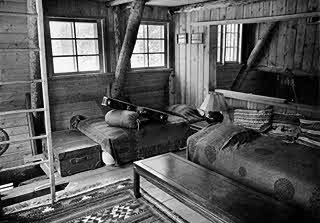
• What did you do after you got out? • I went into the Army for six months. Fort Bliss. Then I went to Mexico for six months on a motorcycle and came back and went to Europe. I was supposed to go for just a month for my sister's wedding in Paris, but I stayed for two years, and I met Lydia. • Where did you meet her? • In Spain, Malaga — actually Torremolinos. • How did you run across Chuck? • (Lydia) On the Plaza — near the fountain. • We were supposed to be in Spain starting a water ski school — Walter's giant water ski school. • (Lydia) But the boat kept sinking! • The boat wasn't any good. It was always supposed to be anchored, but we would come back and there wouldn't be anything to tell except the rope... and we'd have to haul it back up out of the water. Oh, it was really terrible! • You were in Europe for two years, and then came back, right? • Yes, and that's when I came through here to see Walter, you see, because I had met him over there. Then Lydia came here that fall and we got married, and then the next year we took our round-the-world jaunt. • And now tomorrow you're leaving for another trip? • Yeah. Paris to see friends, then southward through some of the out-of-thetrack parts of France and Spain, and then the south coast of Portugal. Then if time permits, possibly Sicily and southern Italy... |
|
Original format: Twenty-eight page booklet, 8-7/8 by 6 inches oblong, bound at the top. Several photos are omitted here to reduce download time. Photos and text by Bob Chamberlain. |
|
|
|
|
|
|
|